Insects
Mt. Takao is considered one of the three major habitat of insects along with Minoo (Osaka prefecture) and Kibune (Kyoto prefecture) and it has long been loved by researchers of insects because of number of species and the easy access from the Metropolitan area. There are many insects first found in Mt. Takao and named after "Takao" such as Takao Shachihoko (Hiradonta takaonis Matsumura) and Takao medaka kamikiri (Stenhomalus takaosanus).
-
Chloridolum viride Cerambycidae
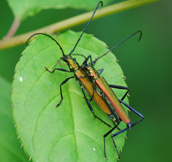
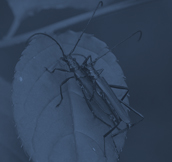 Chloridolum viride Cerambycidae
Chloridolum viride Cerambycidae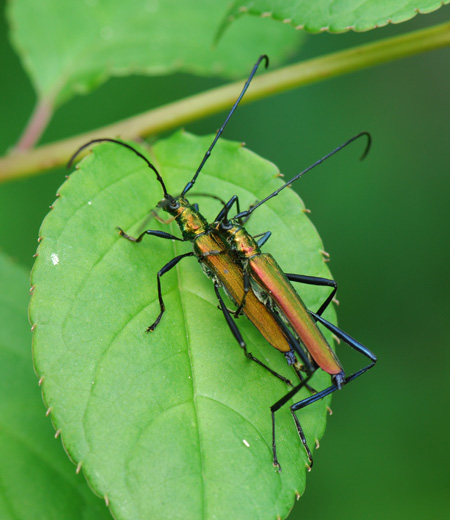 Main Region: Hokkaido, Honshu, Shikoku, Rebun Island, Tsushima, Oki Island and Yaku Island.
Main Region: Hokkaido, Honshu, Shikoku, Rebun Island, Tsushima, Oki Island and Yaku Island.
Found in forests and woods from flatlands to mountains.
Body shape is slim and its color is metallic and shiny green as Japanese name Midori-kamakiri literally meaning green longicorn states but some parts looks reddish by viewing angles.
Have small-paired protrusions on the sides of thorax. Have long legs that are longer than body length.
Often found around sunny woods and feed on nectar of flowers of viburnum dilatatum, deutzia crenata and Japanese chestnuts.
Larvae feed on woods of Japanese chestnuts, quercus acutissima and quercus serrata.
Male guards female after mating and protects her from the copulation attempts by other male until she lays eggs.
●Length about 15 to 21 mm
●Adults Flight Season May to about August -
Purpuricenus temminckii Cerambycidae
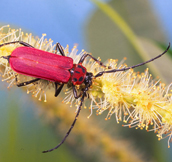
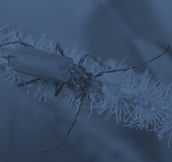 Purpuricenus temminckii Cerambycidae
Purpuricenus temminckii Cerambycidae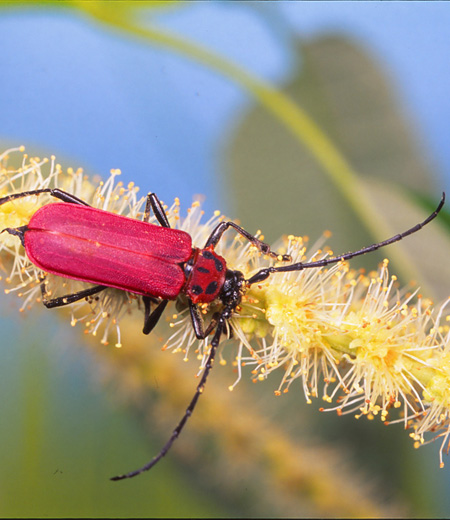 Main Region: Hokkaido, Honshu, Shikoku, Kyushu, Sado Island, Oki Island and Tsushima.
Main Region: Hokkaido, Honshu, Shikoku, Kyushu, Sado Island, Oki Island and Tsushima.
Found in woods and green spaces from flatlands to low elevations.
Color of thorax and fore wings is bright red as the Japanese name Beni-kamikiri literally meaning red longicorn with black spots states and thorax has black spots.
Color of head and antennae is black.
Antennae of male are longer than body length and those of female are about the same length with the body, making it easy to distinguish male and female.
Similar purpuricenus spectabilis can be identified with their paired black spots on the lower parts of fore wings.
Are seen from early spring and feed on nectar of welsh onion, Japanese chestnuts and toxicodendron succedaneum.
Larvae feed on dead bamboo including moso bamboo and Japanese timber bamboo.
Emerged adults are sometimes found in bamboo hedge.
●Length about 13 to 17 mm
●Adults Flight Season April to about August -
Anaglyptus bellus Cerambycidae
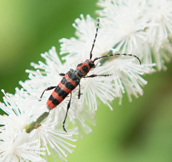
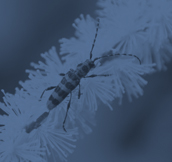 Anaglyptus bellus Cerambycidae
Anaglyptus bellus Cerambycidae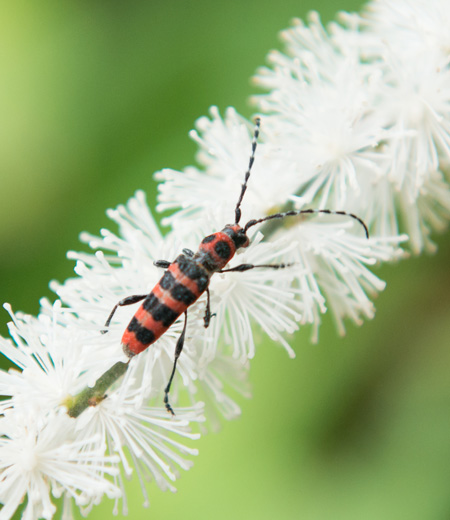 Main Region: Honshu, Shikoku and Kyushu.
Main Region: Honshu, Shikoku and Kyushu.
Found in forests and green space from flatlands to mountains.
Is a clytrini tribe and have red stripe patterns as the Japanese name Aka-suji-torakamikiri literally meaning red stripes clytrini states.
This red color varies among individuals of the same species from bright red, orangey to pinkish red.
Body length is less than 2 cm and small but antennae and legs are thick, making it look masculine.
Have similar patterns in clytrini tribe but this species can be easily identified with these body features. Adults feed on timbers of Japanese zelkova and tree barks of large trees and nector of Japanese knotweed, celtis jessoensis and date plum.
Larvae feed on woods of celtis sinensis, celtis jessoensis and date plum.
●Length about 13 to 17 mm
●Adults Flight Season August to about October -
Paraclytus excultus Cerambycidae
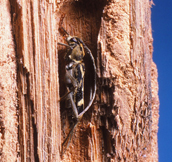
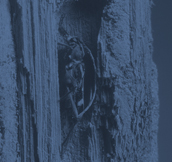 Paraclytus excultus Cerambycidae
Paraclytus excultus Cerambycidae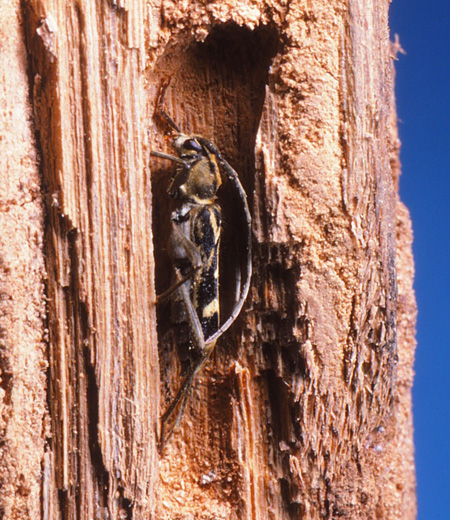 Main region: Hokkaido, Honshu, Shikoku, Kyushu, Rishiri Island, Sado Island, Oki Island and Tsushima.
Main region: Hokkaido, Honshu, Shikoku, Kyushu, Rishiri Island, Sado Island, Oki Island and Tsushima.
Found in forests and grasslands from flatlands to mountains.
Japanese name Shiro-tora-kamikiri literally meaning white tiger cerambycidae was named because of the base body color is nearly white.
There are other species in clytini tribe with similar body color but this species is distinguished by not having black patterns on the center of the back.
Are small species about a bit longer than 1 cm and seen from early May.
Fly in rich grasslands during daytime and feed on pollen and nectar of Japanese chestnuts, plants in aceraceae family and Hydrangea paniculata.
Female adults lay eggs in deadwoods and logged timbers of Japanese beech, quercus myrsinifolia and Japanese zelkova and larvae grow within and feed on these deadwoods.
●Length about 10 to 16 mm
●Adult Flight Season May to about August -
Anoplophora malasiaca (White-spotted Longicorn Beetle) Cerambycidae
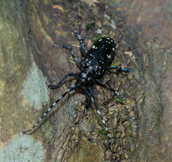
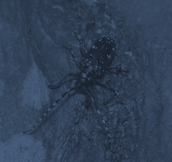 Anoplophora malasiaca (White-spotted Longicorn Beetle) Cerambycidae
Anoplophora malasiaca (White-spotted Longicorn Beetle) Cerambycidae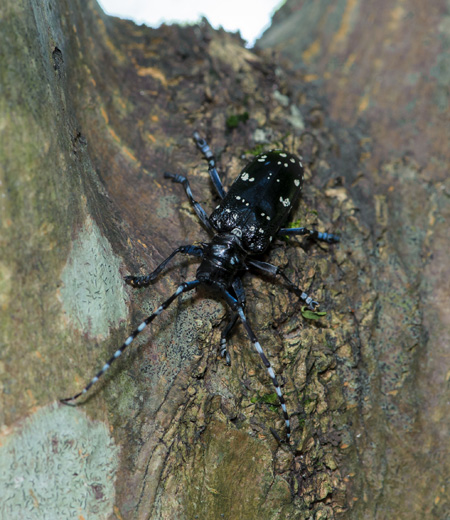 Main region: Hokkaido, Honshu, Shikoku, Kyushu, Okinawa, Sado Island, Oki Island, Tsushima, Tanega Island and Yaku Island.
Main region: Hokkaido, Honshu, Shikoku, Kyushu, Okinawa, Sado Island, Oki Island, Tsushima, Tanega Island and Yaku Island.
Found in woods from flatlands to mountains.
Are most well-known species in cerambycidae family as both adults and larvae feed on various kinds of plants in salicaceae family, castanopsis genus, rutaceae family and aceraceae family that could be found in farmlands.
In Mt. Takao, are often found in mountain trails.
Shiny black body has some white spots.
Antennae are light blue and black stripe patterns and their length are double the size of body length for male and 1.2 times longer for female adults.
Sometimes cause serious damage to trees at gardens and streets.
●Length about 25 to 35 mm
●Adult Flight Season June to about August -
Psacothea hilaris(Yellow-spotted Longicorn Beetle) Cerambycidae
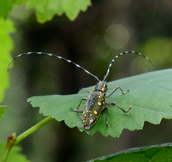
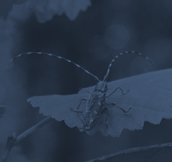 Psacothea hilaris(Yellow-spotted Longicorn Beetle) Cerambycidae
Psacothea hilaris(Yellow-spotted Longicorn Beetle) Cerambycidae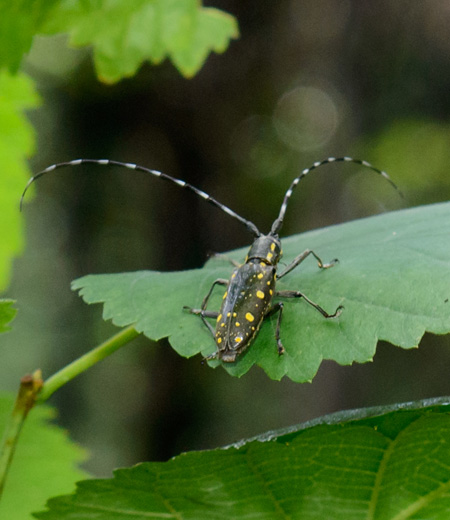 Main region: Honshu, Shikoku, Kyushu, Oki Island, Iki Island and Tsushima.
Main region: Honshu, Shikoku, Kyushu, Oki Island, Iki Island and Tsushima.
Found in forests from flatlands to low elevations but also in farmlands and street trees in cities.
Have long antennae and that of male is three times longer than the body size.
Body color is black with white-yellow to yellow spots.
Are seen from early summer to early autumn and feed on leaves and barks of fig tree, mulberry and plants in rutaceae family with its strong mandibles.
Are also attracted to lights.
Female adults make cracks to these trees and lay eggs.
Hatched larvae feed within these trees and grow.
●Length about 14 to 30 mm
●Adult Flight Season May to about November -
Eutetrapha ocelota Cerambycidae
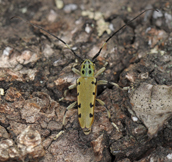
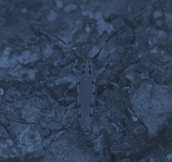 Eutetrapha ocelota Cerambycidae
Eutetrapha ocelota Cerambycidae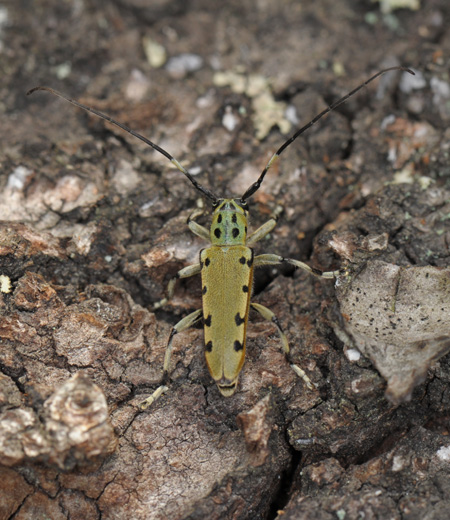
Main region: Hokkaido, Honshu, Shikoku, Kyushu, Sado Island, Oki Islands, Tsushima, Tanega Island and Yaku Island.
Found in forests and green spaces from flatlands to mountains.
Body is covered by short hair and looks yellow to blue-green depends on the different shades of the hair. Eight black spots along the edges of hard outer wings, hence the Japanese name Yatsu-me-kamikiri literally meaning eight eyes cerambycidae.
Two black spots on head and four on thorax are regularly placed that is said to be imitating parmotrema tinctorum often grow on barks of ume (Japanese apricot) and cherry blossoms.
Are seen from early summer and feed on barks of old woods, deadwoods and fallen woods of prunus sargentii, ume (Japanese apricot), Cerasus ×yedoensis (Matsum.) A.V.Vassil. 'Somei- yoshino', Japanese lime.
Are often attracted to lights.
Larvae feed on woods in amygdaloideae sub-family like adults.
●Length about 10 to 18 mm
●Adult Flight Season May to about July
-
Paraglenea fortune(Ramie Longicorn Beetle) Cerambycidae
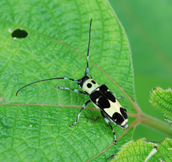
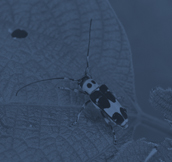 Paraglenea fortune(Ramie Longicorn Beetle) Cerambycidae
Paraglenea fortune(Ramie Longicorn Beetle) Cerambycidae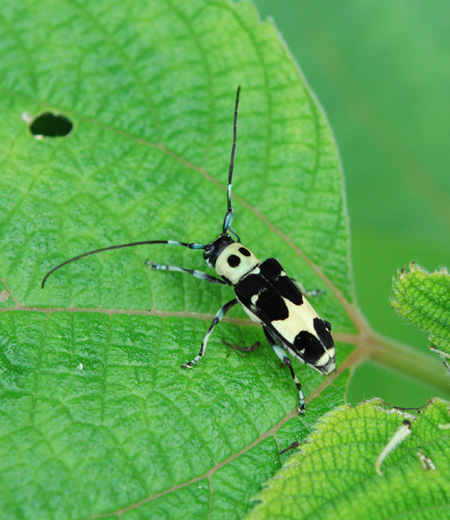 Main region: Honshu (West of Kanto region), Shikoku, Kyushu, Tsushima, Oki Island and Tanega Island.
Main region: Honshu (West of Kanto region), Shikoku, Kyushu, Tsushima, Oki Island and Tanega Island.
Found in woods and surrounding green space from flatlands to mountains.
This is a foreign species came to Nagasaki port with ramie in urticaceae family imported from China during Edo-period.
Main region came up north due to global warming.
Body color is beautiful with white-green and large black spots.
There were not any in Mt. Takao but started to be seen from early 1990s.
Is now one of the species in cerambycidae often seen from May to August.
Are active during daytime and feed on leaves and stems of ramie, boehmeria nivea var. nipononivea, boehmeria japonica, Japanese lime and hibiscus syriacus.
Larvae feed on stems and roots of same plants that adults feed on.
●Length about 10 to 20 mm
●Adult Flight Season May to about August -
Batocera lineolata (White Stripe Long-horned Beetle) Cerambycidae
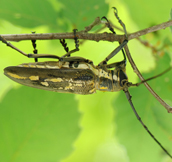
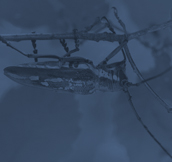 Batocera lineolata (White Stripe Long-horned Beetle) Cerambycidae
Batocera lineolata (White Stripe Long-horned Beetle) Cerambycidae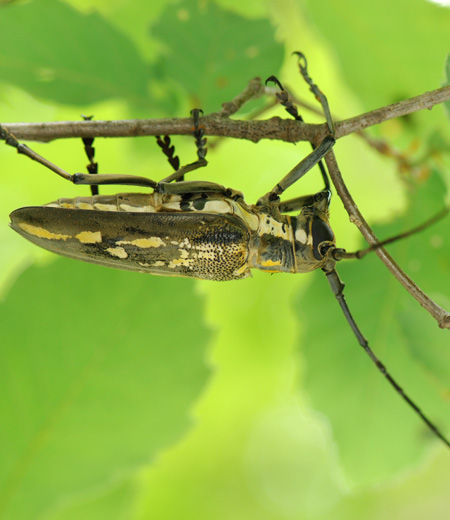 Main Region: Honshu, Shikoku, Kyushu, Sado Island, Oki Island, Tsushima and Amami Island.
Main Region: Honshu, Shikoku, Kyushu, Sado Island, Oki Island, Tsushima and Amami Island.
Found in forests and green space from flatlands to mountains.
Is the largest species in longicorn native to Japan and the large ones become almost 6 cm.
Body color is black covered with gray short hairs.
Have yellow irregular stripes on fore wings but these patterns fade to white when mounted, hence the Japanese name Shirosuji-kamikiri literally meaning white stripes longicorn.
Have large compound eyes and well developed mandibles.
Are active at night but sometime even during daytime.
Adults feed on barks of trees in salicaceae, juglandaceae, betulaceae, fagaceae and ulmaceae grow in wood and also feed on sap of these trees.
Larvae feed on woods of Japanese chestnuts, quercus acutissima and trees in castanopsis family.
●Length about 45 to 55 mm
●Adults Flight Season June to about August -
Paracycnotrachelus longicornis Attelabidae
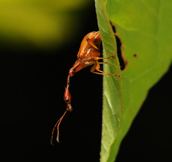
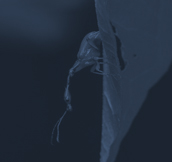 Paracycnotrachelus longicornis Attelabidae
Paracycnotrachelus longicornis Attelabidae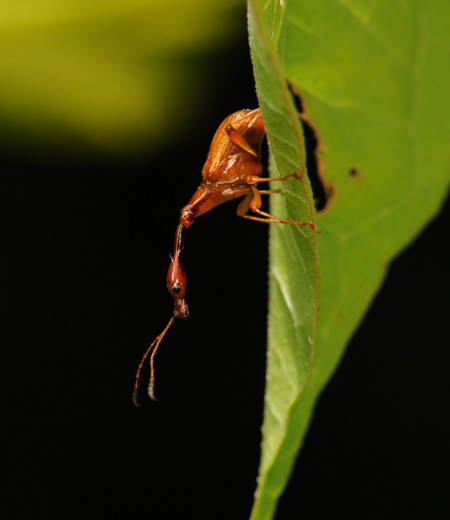 Main Region: Hokkaido, Honshu, Shikoku and Kyushu.
Main Region: Hokkaido, Honshu, Shikoku and Kyushu.
Found in woods and grasslands from flatlands to mountains.
Body color varies among individuals of the same species, some have yellow-brown but most of them have glossy red-brown to dark-brown.
Male and female are different in body shape, male have elongated head and thorax with long antennae, hence the Japanese name Hige-naga-otosibumi literally meaning barbs long attelabidae.
Male is larger than female. Female does not have long thorax and antennae and resemble apoderus rubidus.
Are seen from early summer to midsummer.
Make cradle with leaves of lindera praecox, kobushi magnolia, Japanese knotweed, lindera sericea and lindera erythrocarpa and drop the cradle to the ground.
●Length about 8 to 12 mm
●Adults Flight Season May to about July -
Dermatoxenus caesicollis Curculionidae
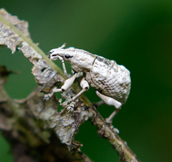
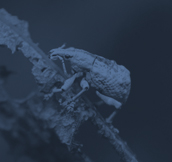 Dermatoxenus caesicollis Curculionidae
Dermatoxenus caesicollis Curculionidae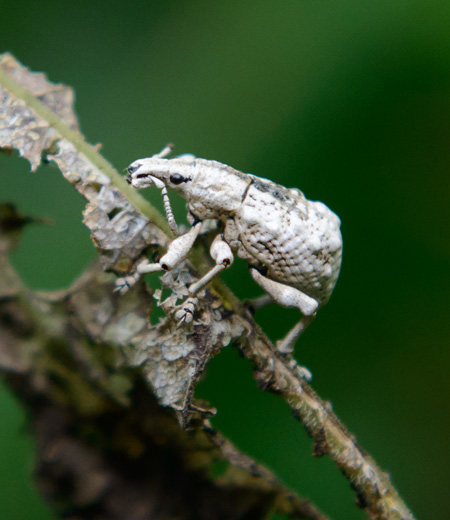 Main Region: Honshu, Shikoku, Kyushu, Okinawa, Tsushima and Yaku Island.
Main Region: Honshu, Shikoku, Kyushu, Okinawa, Tsushima and Yaku Island.
Found in woods and surrounding green spaces from flatlands to mountains.
Body color is mostly gray-white but this is because the entire body is covered by fine powder-like particles that are easy to come off and gradually base color become more distinctive.
Fore wings are slightly bumpy with paired humps-like protrusions on the lower parts.
These protrusions are small as the Japanese name Hime-shiro- kobu-zoumushi literally meaning small white humps curculionidae states compare to similar episomus turritus.
Are seen from spring to summer. Feed on leaves of Japanese aralia, oudo and aralia elata and often rest on leaves of these plants.
●Length about 11 to 14 mm
●Adults Flight Season April to about July -
Lixus impressiventris Curculionidae
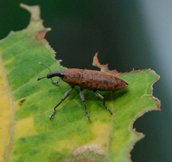
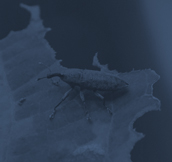 Lixus impressiventris Curculionidae
Lixus impressiventris Curculionidae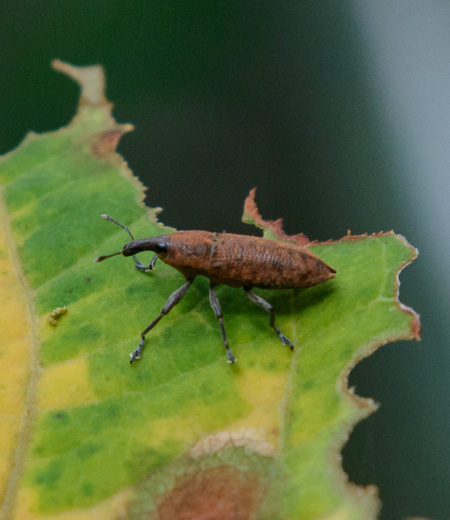 Main Region: Hokkaido, Honshu, Shikoku, Kyushu and Tsushima.
Main Region: Hokkaido, Honshu, Shikoku, Kyushu and Tsushima.
Found in woods and green space from flatlands to mountains.
The unique name Katsuo-zoumushi literally meaning bonito curculionidae was named because the body shape is elongated streamline shaped and covered with red-brown powders that resemble dried bonito, katsuo-bushi.
Somehow the word bushi (ship-shape used to be called) was eliminated from the name of this species.
When red-brown powders come off, base color of black appears.
Tips of fore wings are pointed.
Similar lixus acutipennis have v-shaped black patterns on fore wings and have wider tips Feed on leaves of plants in polygonaceae family including fallopia japonica and water pepper often rest on these leaves.
Larvae feed on the center portions of stems of the plants adults feed on.
●Length about 10 to 12 mm
●Adults Flight Season May to about August -
Mesalcidodes trifidus Curculionidae
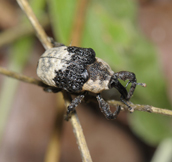
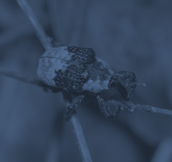 Mesalcidodes trifidus Curculionidae
Mesalcidodes trifidus Curculionidae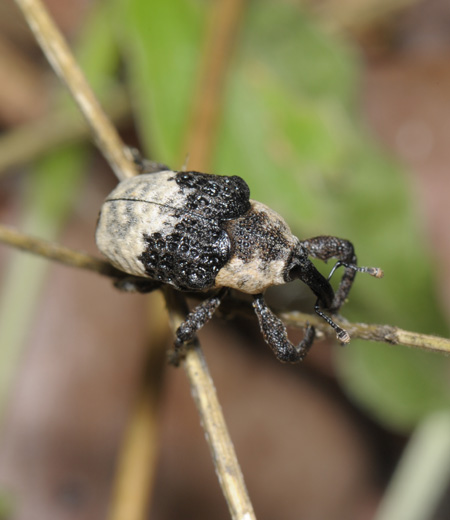 Main Region: Honshu, Shikoku and Kyushu.
Main Region: Honshu, Shikoku and Kyushu.
Found in forests, surrounding green spaces and grasslands from flatlands to mountains.
Body color is black with fine hairs are densely placed called scaly hairs and this part looks white.
The lower parts of fore wings are mostly white, hence the Japanese name Ojiro-ashinaga-zomushi literally meaning tail white long legs curculionidae.
Long legs curculinidae are only to categorize within curculionidae family and the legs of this species are not long.
Are seen from spring and larvae feed on leaves of kudzu and often seen on leaves of the plants.
When noticing danger, fold legs and the entire body become very stiff as if it is dead.
Female lays eggs by making cuts on stems of kudzu and emerged larvae feed on center portion of the stems and grow.
●Length about 9 to 10 mm
●Adults Flight Season April to about October -
Sipalinus gigas Rhynchophoridae
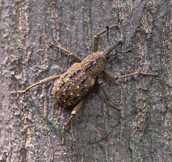
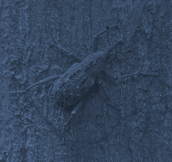 Sipalinus gigas Rhynchophoridae
Sipalinus gigas Rhynchophoridae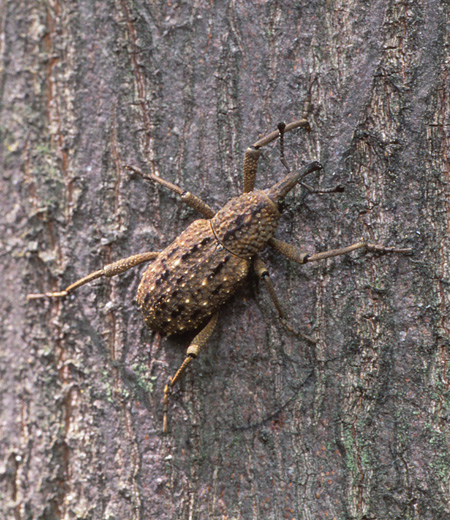 Main Region: Hokkaido, Honshu, Shikoku, Kyushu, Okinawa, Izu Islands and Tsushima.
Main Region: Hokkaido, Honshu, Shikoku, Kyushu, Okinawa, Izu Islands and Tsushima.
Found in woods and forests from lowlands to mountains.
Body color is brown with some black spots but originally the base color was black and black body color appears when they live longer.
Body surface is cast metal-like and very stiff.
Japanese name Oo-zomushi literally meaning large curculionidae was named because this species have elongated distinct mouthparts like an elephant (curculionidae in Japanese literally meaning elephant insects).
Are the largest species in curculionidae family in Japan.
Adults are seen from early summer to midsummer.
Feed on sap of quercus acutissima and quercus serrata.
During daytime, rest under fallen trees and deadwoods.
Adults live for about two years after adult emergence.
Female lays eggs inside of woods and larvae feed on woods and goes deep inside of woods.
●Length about 12 to 29 mm
●Adults Flight Season June to about September -
Vespa mandarinia japonica(Japanese Giant Hornet) Vespidae
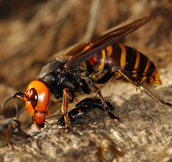
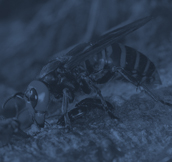 Vespa mandarinia japonica(Japanese Giant Hornet) Vespidae
Vespa mandarinia japonica(Japanese Giant Hornet) Vespidae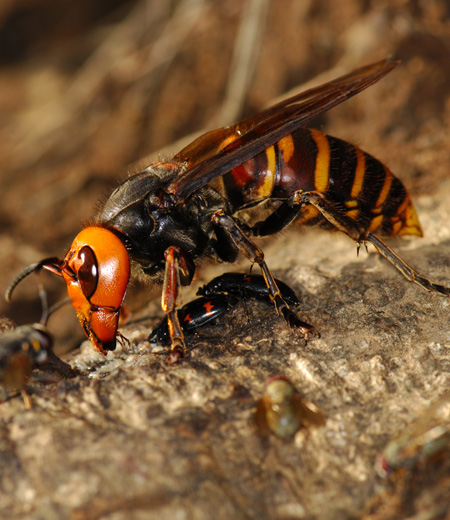 They live widely in Hokkaido, main land Honsyu, Shikoku, Kyusyu as well as Yakushima Island and Tanegashima Island.
They live widely in Hokkaido, main land Honsyu, Shikoku, Kyusyu as well as Yakushima Island and Tanegashima Island.
Thought they inhabit in plain ground and low-mountain areas, they also go out to residential districts.
As largest species of Japanese bees, the striped patterns of thick orange color and black color on their body accentuate them very much.
Their dwelling is the den made under the ground, where they usually inhabit.
Carnivorous as they are, their main bait is mainly big insects; meanwhile they attack the other bees’ dwelling in the group so that they can get other’s pupae and larva for their own feed.
Sap from copse trees is also where they like to gather.
They are very notorious for its aggressiveness and have deadly poison which can stab human to death.
The point is that when you see them or hear the sound of flapping wings ‘Buz’, don’t be upset or panicked to leave there at ease.
Another point to remember is that they gather at sweet drinks or Bento.
●Length about 27 to 45 mm
●Adult Flight Season April to about October -
Vespa simillima xanthoptera Vespidae
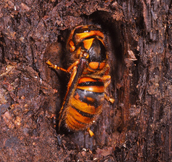
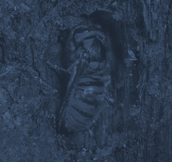 Vespa simillima xanthoptera Vespidae
Vespa simillima xanthoptera Vespidae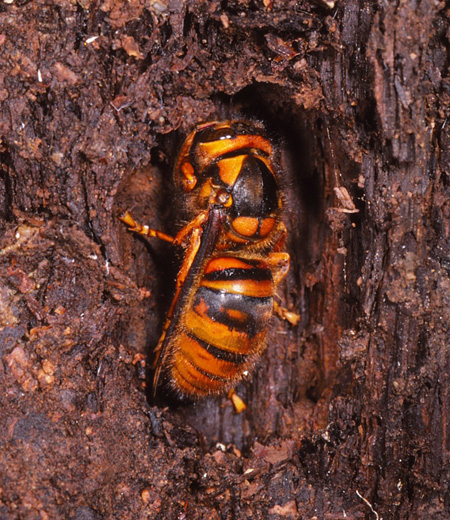 They live widely in main land Honsyu, Shikoku, Kyusyu as well as Sado Island, Tsushia Island and Yakushima Island.
They live widely in main land Honsyu, Shikoku, Kyusyu as well as Sado Island, Tsushia Island and Yakushima Island.
They live near populated area with trees growing thickly or copses in low lands to undeveloped woodlands.
They are medium size hornet smaller by one size than Japanese giant hornet.
Worker bees are about 20 mm, male about 20 to 24 mm , Queen Bee about 25 to 28 mm.
Early spring is the season they begin to appear and start to make their spherical shape beehive in the hollow on the trees or underground.
Recent years, the problem is they make their beehives such as overhangs of a Japanese roof of residential house, walls of residence in urban areas.
As its name shows their body color is conspicuous yellow.
As their characteristic is so offensive that even small stimulus urges them to attack humans.
Therefore, it’s recommended not to come near even when you happen to see beehives.
They love nectar or sap, and catch to eat various insects such as cicada at times.
●Length about 20 to 28 mm
●Adult Flight Season April to about November -
Vespula flaviceps lewisii Vespidae
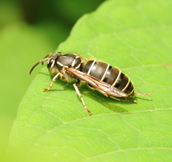
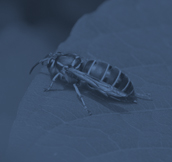 Vespula flaviceps lewisii Vespidae
Vespula flaviceps lewisii Vespidae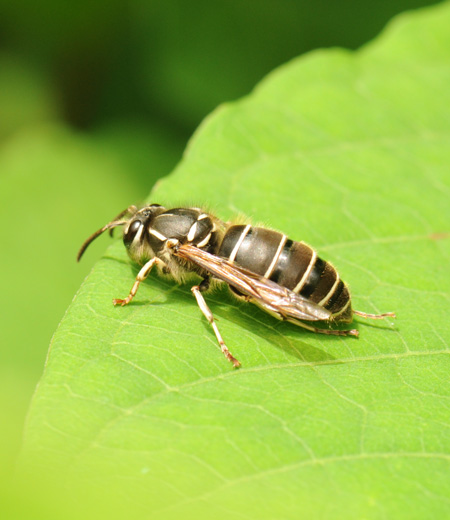 They live widely in Hokkaido, main land Honsyu, Shikoku, Kyusyu as well as Sado Island, Tsushia Islands and Yakushima Island.
They live widely in Hokkaido, main land Honsyu, Shikoku, Kyusyu as well as Sado Island, Tsushia Islands and Yakushima Island.
They live at a dense growth of mountain bushes and green, wooden tract near the area in plain ground and mountain areas.
As the name shows it, their body is characterized of striped pattern of glossy black and white color.
As the spring comes in, they begin to act out and start to make their den mainly underground.
Main bait is insects, spiders, larvae of moth which they love to eat.
Compared with Asian giant hornet and yellow hornet, they are not so offensive and less toxic, but they need to be cautions because this toxin might cause Anaphylaxie shock depending upon citizen.
They are also well known as ‘Ji-Ba-Chi’ (local bee) and people in Nagano Prefecture have a habit of eating the larvae and pupa.
●Length about 10 to 16 mm
●Adult Flight Season March to about November -
Parapolybia indica indica Vespidae
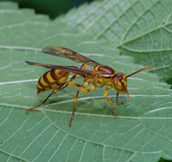
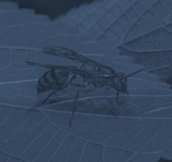 Parapolybia indica indica Vespidae
Parapolybia indica indica Vespidae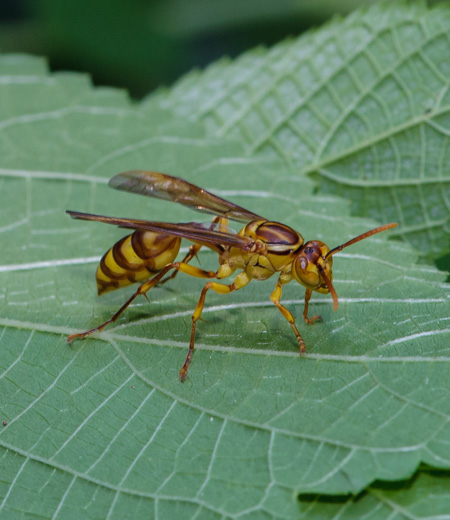 They live widely in main land Honsyu, Shikoku, Kyusyu as well as Sado Island, Tsushia Islands and Yakushima Island.
They live widely in main land Honsyu, Shikoku, Kyusyu as well as Sado Island, Tsushia Islands and Yakushima Island.
They live in plain ground, woods in the mountainous district, and green tract near the area.
They are a kind of paper wasp flying with their long rear legs dangling.
Although Parapolybia indica and Parapolybia varia are similar, the latter bee can be distinguished from the former one by black striped on the head which original breed Parapolybia indica does not have.
They are named after this fact. Early spring is the time they come out and appear to make breeding hive on the leaves and at the back of leaves of shrubs.
The body color characteristic is slightly shaded yellow and mottled pattern of pale brown.
Though thin sized and small, they are exceedingly offensive.
At the best time for their breeding season, more than 100 working bees are there at the beehive.
Thus, be sure to remember not to come closer to the beehive.
Main bait is insects such as larvae of moth.
●Length about 14 to 20 mm
●Adult Flight Season April to about October -
Xylocopa appendiculata Apidae
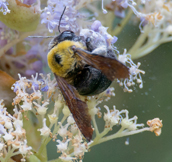
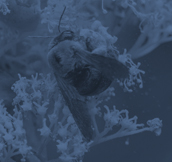 Xylocopa appendiculata Apidae
Xylocopa appendiculata Apidae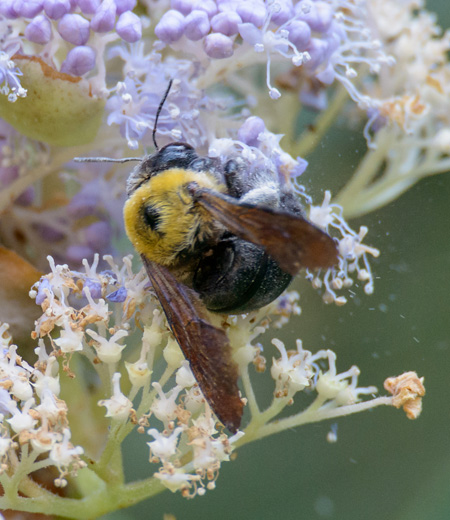 They live widely in main land Honsyu, Shikoku, Kyusyu as well as Tsushima Island and Yakushima Island.
They live widely in main land Honsyu, Shikoku, Kyusyu as well as Tsushima Island and Yakushima Island.
Thought they inhabit at copse at the mountain areas, and around the green tract areas in plan ground, consequently, we can see them in the garden or park in residential districts.
Early spring to early summer, they boom out to appear for various flowers to collect pollen and nectar for their own bait.
Male Apidae has their own territory at the mountain ridge or plain field and we can sometimes see them watching to protect their own territory while they’re hovering.
They dig out shrub or withered branch for breeding place to raise their children in there.
As their sounds of wings are loud and they are densely covered with thick hair, we tend to be afraid of them, but the fact is they’re docile and hardly attack human.
●Length about 20 to 24 mm
●Adult Flight Season March to about October -
Cyphononyx dorsalis Pompilidae
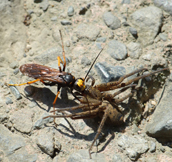
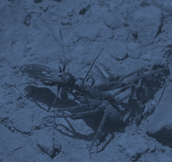 Cyphononyx dorsalis Pompilidae
Cyphononyx dorsalis Pompilidae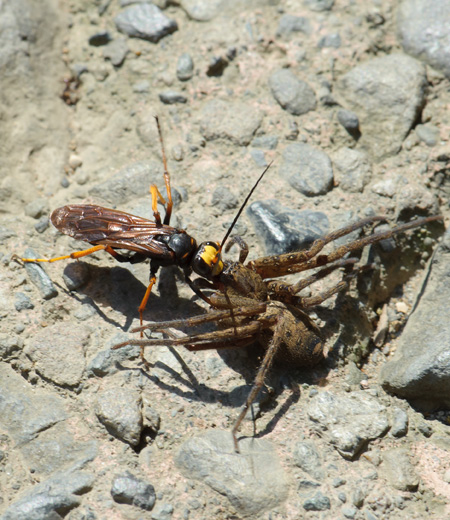 Main Region: Honshu, Shikoku, Kyushu and Okinawa. Is a group of bees catch spiders for larvae and found in areas where many spiders inhabit such as edges of forests, grasslands with some trees. The Japanese name Bekko-bachi literally meaning amber bee because the body color is reddish yellow that is like the color of tortoise of hawksbill turtle. Act in solo and does not create own nest but dig a hall, put some spiders and lay eggs, thus larvae can live by consuming the spiders. Spiders do not go bad because they are paralyzed with bee sting.
Main Region: Honshu, Shikoku, Kyushu and Okinawa. Is a group of bees catch spiders for larvae and found in areas where many spiders inhabit such as edges of forests, grasslands with some trees. The Japanese name Bekko-bachi literally meaning amber bee because the body color is reddish yellow that is like the color of tortoise of hawksbill turtle. Act in solo and does not create own nest but dig a hall, put some spiders and lay eggs, thus larvae can live by consuming the spiders. Spiders do not go bad because they are paralyzed with bee sting.
●Length about 17 to 25 mm
●Adults Flights Season July to about September -
Camponotus japonicas Formicidae
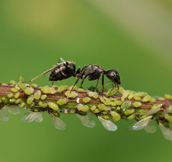
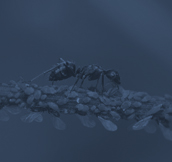 Camponotus japonicas Formicidae
Camponotus japonicas Formicidae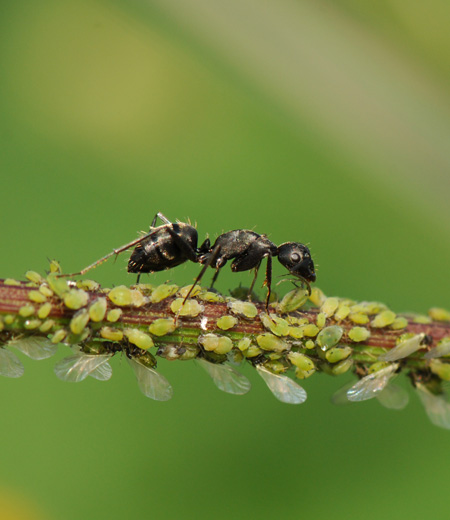 Main Region: Hokkaido, Honshu, Shikoku, Kyushu, Tsushima and Yaku Island. Found in grasslands from flatlands to mountains. Create nest in open ground, thus often found at parks and gardens even in cities. Is the largest species in formicidae native to Japan, worker ants are about 10 mm and queen ant is 17 mm. Body color is black with brownish abdomen. Live in a large colony with a queen ant in underground lair. Catching foods are the job for worker ants. Work in solo or with some and feed on dead insects and body fluids of plant louse. From May to June, male ant with wings and queen ant come out from lair for marriage flight. When they are back on ground, female ant drop wings and create another lair. Take care of some of emerged ants in early stages but once they become worker ants, she becomes queen ant continuously lay eggs.
Main Region: Hokkaido, Honshu, Shikoku, Kyushu, Tsushima and Yaku Island. Found in grasslands from flatlands to mountains. Create nest in open ground, thus often found at parks and gardens even in cities. Is the largest species in formicidae native to Japan, worker ants are about 10 mm and queen ant is 17 mm. Body color is black with brownish abdomen. Live in a large colony with a queen ant in underground lair. Catching foods are the job for worker ants. Work in solo or with some and feed on dead insects and body fluids of plant louse. From May to June, male ant with wings and queen ant come out from lair for marriage flight. When they are back on ground, female ant drop wings and create another lair. Take care of some of emerged ants in early stages but once they become worker ants, she becomes queen ant continuously lay eggs.
●Length about 7 to 13 mm (Worker ants)
●Adults Flights Season April to about November -
Camponotus obscuripes Formicidae
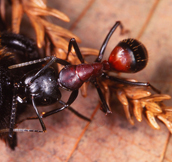
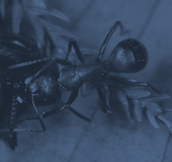 Camponotus obscuripes Formicidae
Camponotus obscuripes Formicidae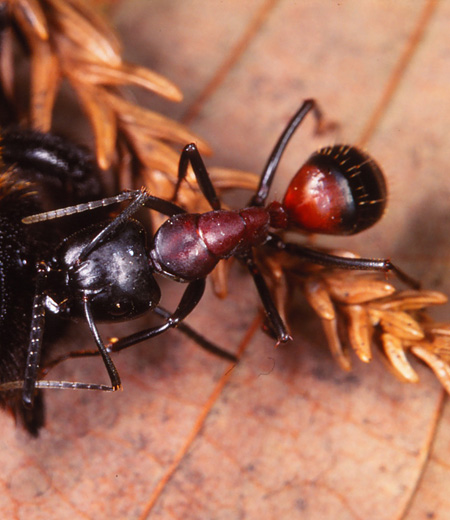 Main Region: Hokkaido, Honshu, Shikoku, Kyushu, Yaku Island and Tsushima.
Main Region: Hokkaido, Honshu, Shikoku, Kyushu, Yaku Island and Tsushima.
Found in forests and grasslands from flatlands to mountains.
Are the largest species like camponotus japonicus habit in Japan and its queen ant is nearly 2 cm.
Color of head and legs are black and that of thorax and the front part of abdomen are red-brown.
Some species have red-brown color only on thorax.
Hardly ever seen in cities as they normally built a next in dead woods or root of tree in forests not in soils. Worker ants are often seen on grounds, generally work in solo and do not form a line.
Feed on dead insects and aphid honeydew.
●Length about 7 to 12 mm
●Adults Flight Season May to about October -
Orthetrum albistylum speciosum (Common Skimmer) Libellulidae
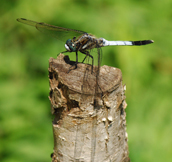
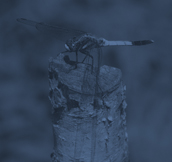 Orthetrum albistylum speciosum (Common Skimmer) Libellulidae
Orthetrum albistylum speciosum (Common Skimmer) Libellulidae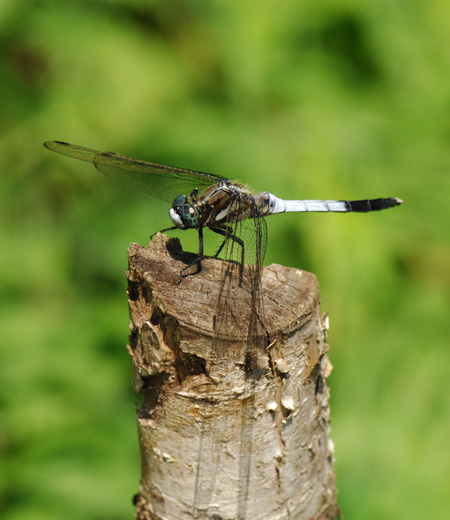 Main region: Hokkaido, Honshu, Shikoku, Kyushu and Okinawa.
Main region: Hokkaido, Honshu, Shikoku, Kyushu and Okinawa.
Found in sunny grassland at waterside of ponds from flatland to low elevations.
Also fly to puddles and one of the dragonflies frequently found in town.
Right after adult emergence in spring, both male and female body colors are brownish yellow with black dots on abdomen.
Only male bodies gradually turn to black with age and from thorax to middle of abdomen are covered by powdery white like salt.
This is the origin of Japanese name Shiokara-Tombo literally meaning salted fish guts dragonfly.
Female body color does not change and also called as Mugiwara-Tombo literally meaning straw dragonfly.
Female hovers over water to dip down the tip of abdomen to lay eggs.
●Length about49 to 55 mm
●Adult Flight Season May to about September -
Orthetrum triangulare melania Libellulidae
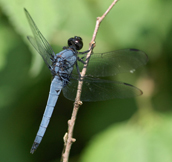
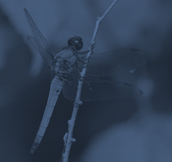 Orthetrum triangulare melania Libellulidae
Orthetrum triangulare melania Libellulidae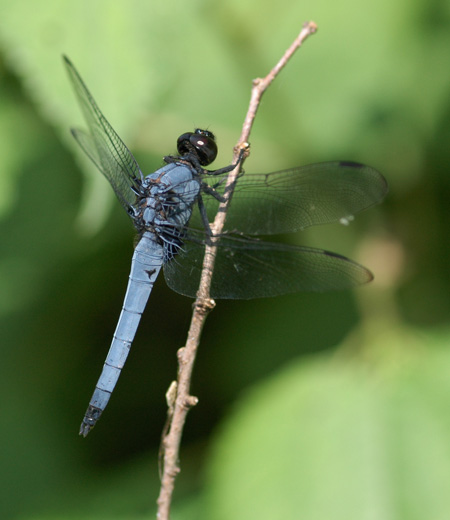 Main region: Hokkaido, Honshu, Shikoku, Kyushu and Okinawa.
Main region: Hokkaido, Honshu, Shikoku, Kyushu and Okinawa.
Found in forests, fields and at waterside of paddy fields and streams from flatlands to low elevations.
Prefer shadowy environment like under the shade of trees.
Body size is larger than common skimmers and male body turns powdery white from thorax to the middle of abdomen but this species is more bluish.
Female body stays brownish yellow like common skimmers.
Common skimmers have blue green eye but this species have black or brownish black.
Abdomen is thick and built.
Main foods are insects, flies, mosquitos, butterflies and moths.
●Length about 50 to 60 mm
●Adults Flight Season May to about November -
Orthetrum japonicum japonicum Libellulidae
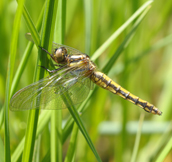
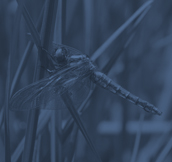 Orthetrum japonicum japonicum Libellulidae
Orthetrum japonicum japonicum Libellulidae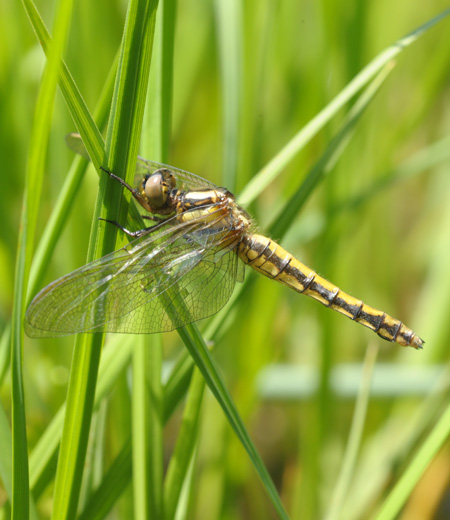 Main region: Hokkaido, Honshu, Shikoku and Kyushu.
Main region: Hokkaido, Honshu, Shikoku and Kyushu.
Found at watersides of swamps, paddy fields, idle farmlands and ponds from flatlands to low elevations.
Adults fly from spring to early summer.
The abdomen of male adults become bluish white and female body is same as common skimmer but body size of this species is smaller.
It is easy to identify the difference from common skimmers because the abdomen of this species is rather fatty and base of the wings are brownish.
●Length about 37 to 45 mm
●Adults Flight Season April to about May -
Sympetrum frequens Libellulidae
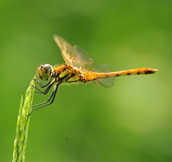
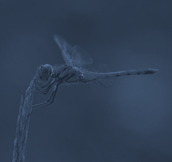 Sympetrum frequens Libellulidae
Sympetrum frequens Libellulidae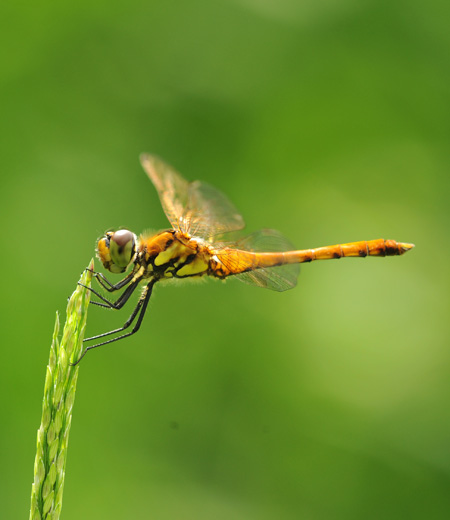 Main region: Hokkaido, Honshu, Shikoku and Kyushu.
Main region: Hokkaido, Honshu, Shikoku and Kyushu.
Is most frequently seen dragonflies and also named as Aka-Tombo literally meaning red dragonfly and has long been used in poetries but head and thorax of this species do not turn red.
The abdomen of male adults turns from orange to deep red with age.
After adult emergence in paddy fields or swamps on hills around June, move to higher mountains to avoid hot summer weather.
As they grow, around September, they move back to flatland or low mountains.
They have reduced in numbers compare to the past, but still found in grassland or idle land apart from the city.
Similar species, sympetrum darwinianum, whole body turns red and found in flatland even in summer.
Main foods are small incects including flies and mosquitos.
●Length about 35 to 45 mm
●Adults Flight Season June to about October -
Sympetrum pedemontanum elatum Libellulidae
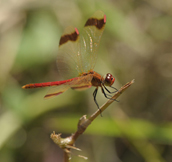
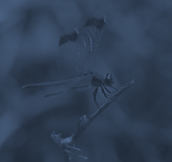 Sympetrum pedemontanum elatum Libellulidae
Sympetrum pedemontanum elatum Libellulidae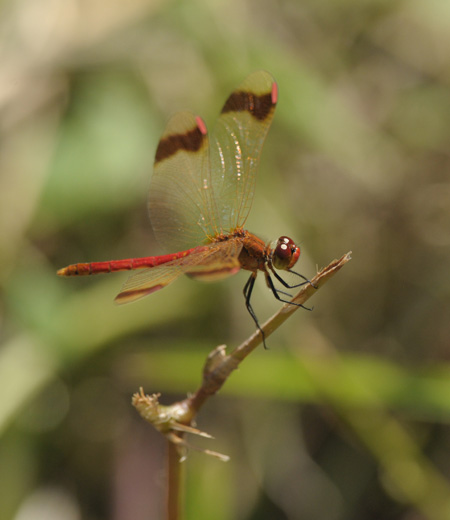 Main region: Hokkaido, Honshu, Shikoku and Kyushu.
Main region: Hokkaido, Honshu, Shikoku and Kyushu.
Found at watersides along slow-flowing streams, paddy fields and ponds from flatland to mountains.
Body turns red like sympetrum frequens, thorax and abdomen of male adults turns red with age.
Tip of front and back wings has brownish sash like patterns that is unique to this species so it is easy to identify.
Body of female adults does not turn red and rather reddish brown.
Have rectangular patterns, red for male and white for female.
Main foods are small insects that they catch while flying.
●Length about 30 to 40 mm
●Adult Flight Season June to about September -
Anotogaster sieboldii (Golden-ringed Dragonfly) Cordulegastridae
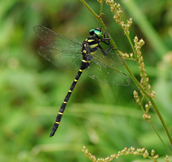
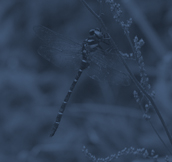 Anotogaster sieboldii (Golden-ringed Dragonfly) Cordulegastridae
Anotogaster sieboldii (Golden-ringed Dragonfly) Cordulegastridae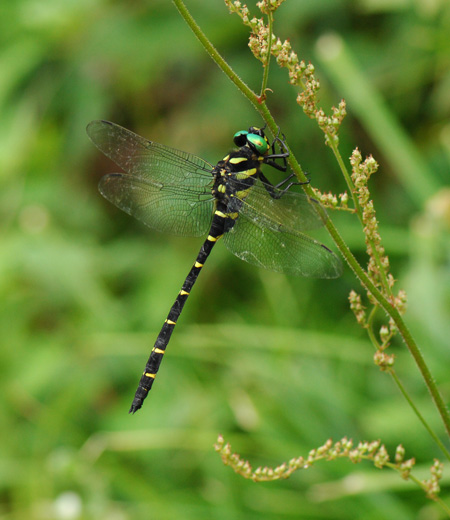 Main region: Hokkaido, Honshu, Shikoku, Kyushu, Okinawa, Sado Island, Tsushima, Yaku Island and Amami Oshima.
Main region: Hokkaido, Honshu, Shikoku, Kyushu, Okinawa, Sado Island, Tsushima, Yaku Island and Amami Oshima.
The largest dragonfly in Japan and its body length become up to about 11 cm.
Found at streams and swamps in flatland to low elevations, and at streams in mountains but seen in city area on rare occasions.
Their body is quite appealing because large eyes are dark green and body is black with yellow regularly placed stripes so it is appealing.
Main foods are small insects and catch them while flying.
Male adults hold territory and patrol within the area.
Female adults hovers dipping abdomen beneath water and lay eggs.
●Length about 90 to 100 mm
●Adult Flight Season June to about October -
Mnais pruinosa Calopterygidae
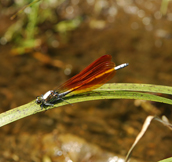
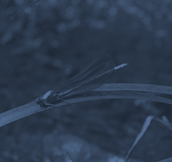 Mnais pruinosa Calopterygidae
Mnais pruinosa Calopterygidae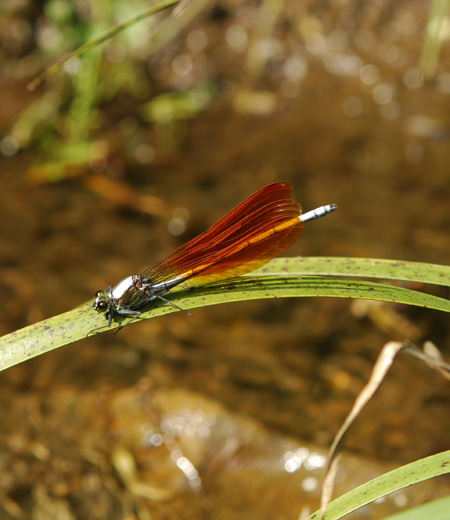 Main region: Wide areas of Hokkaido, Honshu, Shikoku and Kyushu.
Main region: Wide areas of Hokkaido, Honshu, Shikoku and Kyushu.
In Calopterygidae family, body shape is the larger version of damselflies found in clear streams from flatlands to mountains and streams in mountains as its Japanese name Kawa-Tombo literally meaning river dragonfly states.
Front and back wing are almost the same size and fly flutteringly and elegantly.
Color of wings varies among species and regions from reddish brown, light orange to clear.
Body color at young adults is metallic shiny green but it turns powdery white with age.
Main foods are small insects at waterside.
Length about 55 to 60 mm
Adult Flight Season April to about August -
Calopteryx cornelia Calopterygidae
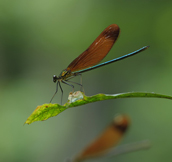
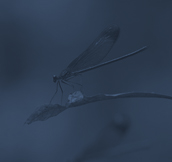 Calopteryx cornelia Calopterygidae
Calopteryx cornelia Calopterygidae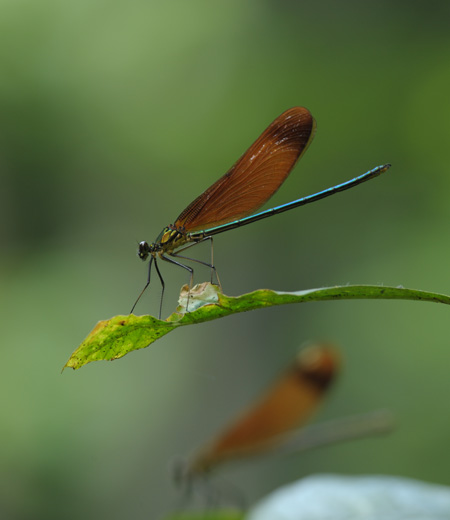 Main region: Hokkaido, Honshu, Shikoku and Kyushu.
Main region: Hokkaido, Honshu, Shikoku and Kyushu.
Found at clear streams and streams from low elevation to mountains.
Is the largest species of calopterygidae in Japan. Main foods are small insects.
Transparent deep brownish wings and metallic green abdomen look elegant when slowing flying at waterside.
Female has white pterostigma at tips of wings and abdomen is brown.
Male adults hold territory and mate with female fly in the territory.
Female lays eggs underwater.
With airy layer trap its body and wings, it can stay underwater nearly one hour.
●Length about 60 to 65 mm
●Adult Flight Season May to about September -
Davidius nanus Gomphidae
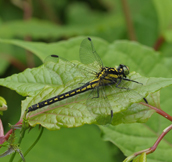
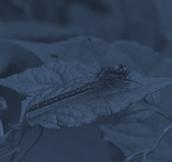 Davidius nanus Gomphidae
Davidius nanus Gomphidae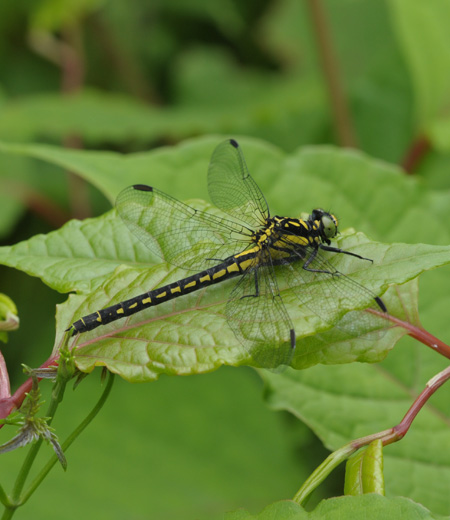 Main region: Honshu, Shikoku, Kyushu and Tsushima.
Main region: Honshu, Shikoku, Kyushu and Tsushima.
Found at streams from midstream to upstream on hills and mountains.
It was named after French zoologist Dr. Davidius Nanus in 19th century.
Body is black with yellow stripes from thorax to abdomen.
Three yellow spots are large on sides of thorax and the base of front legs of both female and male are yellow.
Seen at streams around Mt. Takao area from April to May.
Male hold territory and rest on stones and stay alert while waiting for a female to mate.
Female hovers in air alone and lay on water surface.
●Length about 40 to 50 mm
●Adult Flight Season April to about July -
Davidius fujiama Gomphidae
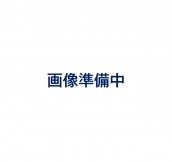
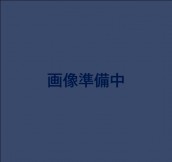 Davidius fujiama Gomphidae
Davidius fujiama Gomphidae Main region: Honshu, Shikoku and Kyushu.
Main region: Honshu, Shikoku and Kyushu.
Found at clear streams near headstreams and streamside from low elevations to mountains.
Is very similar to davidius nanus but abdomen of male davidius fujiama is mostly black as its Japanese name Kuro-Sanae literally meaning black gomphinae states and no yellow patterns on sides of thorax.
Middle yellow spots on sides of thorax are smaller and the base of front legs does not have yellow spots so it is easy to identify the difference.
Female hovers and lay eggs on moss or low-growing plants around waterside.
Main foods are small insects.
Emerge from April, adults can be seen until summer.
●Length about 40 to 50 mm
●Adult Flight Season April to about July -
Sieboldius albardae Gomphidae
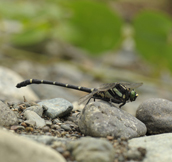
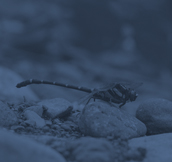 Sieboldius albardae Gomphidae
Sieboldius albardae Gomphidae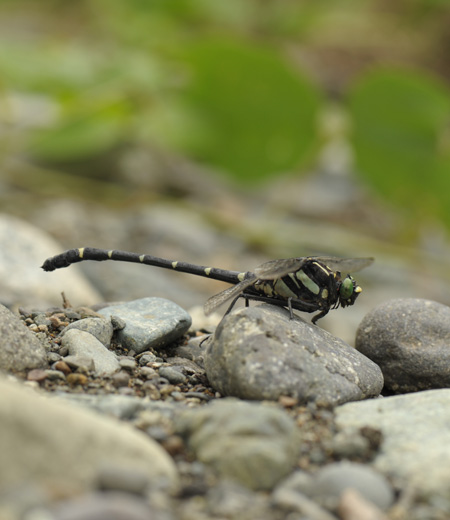 Main region: Hokkaido, Honshu, Shikoku and Kyushu.
Main region: Hokkaido, Honshu, Shikoku and Kyushu.
Found at streamside, grassland near watersides from flatland to low elevations.
Rest on stone or branches with their wings kept outspread.
Emerge from late May to about August.
Japanese name Ko-Oniyanma literally meaning small Oniyanma (Anotogaster Sieboldii) but they are in Gomphinae family.
The largest species in Gomphinae and have small head with same body size and have very long back legs compared to anotogaster sieboldii so it is easy to identified with.
Main foods are various insects including other dragonflies and cedars.
Male hold territory and rest on stone or branches and stay alert and patrol within the territory sometimes.
●Length about 80 to 90 mm
●Adult Flight Season May to about August -
Epiophlebia superstes Epiophlebiidae
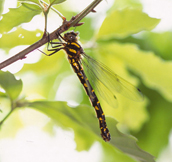
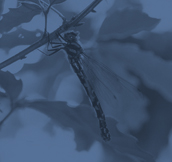 Epiophlebia superstes Epiophlebiidae
Epiophlebia superstes Epiophlebiidae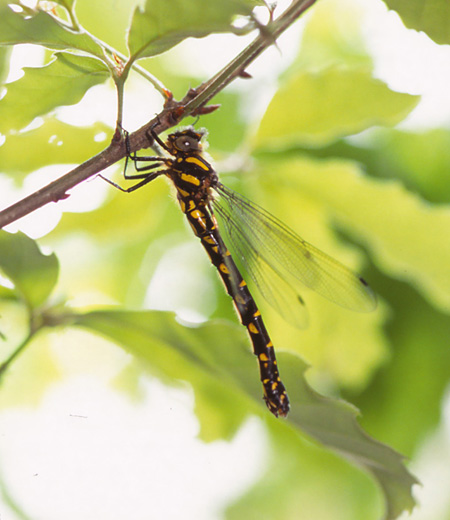 Main region: Hokkaido, Honshu, Shikoku and Kyushu.
Main region: Hokkaido, Honshu, Shikoku and Kyushu.
Globally known as “living fossils” because many parts of their body including reproductive organs.
One other species in epiophlebiidae family remains in Himaraya and North Eastern China.
Body is similar to gomphidae but wings are like damselflies because the shapes of front and back wings are almost the same.
Found at upstream or streams surrounded by woods and main foods are small insects including flies, mosquitos. Female lays eggs on stems of plants at waterside and emerged nymphs live between stones in streams.
Live underwater for seven to eight years, waterside for following one year and then emerge to adults.
●Length about 50 to 60 mm
●Adult Flight Season about May -
Graptopsaltria nigrofuscata Cicadidae
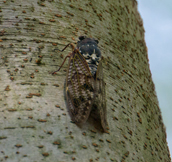
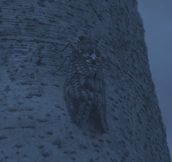 Graptopsaltria nigrofuscata Cicadidae
Graptopsaltria nigrofuscata Cicadidae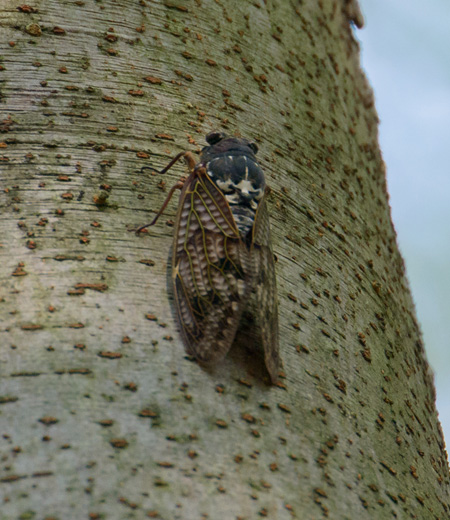 They live widely in Hokkaido, main land Honsyu, Shikoku, Kyusyu as well as Tsushima Island and Yakushima Island.
They live widely in Hokkaido, main land Honsyu, Shikoku, Kyusyu as well as Tsushima Island and Yakushima Island.
Thought they inhabit at copses and forests in plain ground and at the mountain areas, they can take a sip of sap.
They are seen at the park where there are large trees and at the orchard that Japanese pears are grown.
They are one of national wide popular bees to see most occasionally.
Male cicadas only shrill among Cicadoidea and their shrilling sounds like ‘Jyu-ey’ or ‘Jour-Jour-Jour-Jour’.
It is said that their name is taken after this shrilling sound very similar to the frying sound.
Wings are opacity and dark reddish-brown color with patterns of light and shade here and there.
Female lays their eggs into the tree bark.
Eggs incubate about in 1 year.
The larvae live underground on sap sucking from the tree root, and crawl up to the ground in 6 to 7 years to emerge out of pupa into adult insect.
●Length(overall-length from head to wing) about 50 to 60 mm
●Adult Flight Season July to about September -
Meimuna opalifera Cicadidae
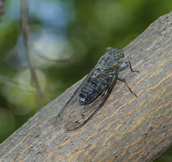
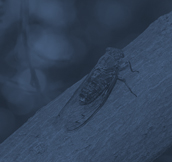 Meimuna opalifera Cicadidae
Meimuna opalifera Cicadidae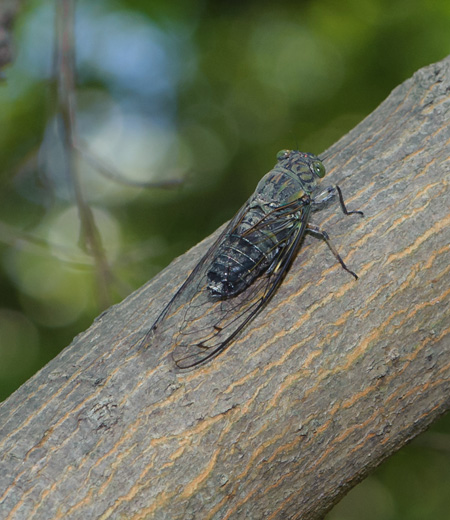 They live widely in Hokkaido, main land Honsyu, Shikoku, Kyusyu as well as Tsushima Island and Yakushima Island.
They live widely in Hokkaido, main land Honsyu, Shikoku, Kyusyu as well as Tsushima Island and Yakushima Island.
Thought they inhabit at trees and copse in plain ground, at the low mountain areas.
We can see them in the public parks in residential districts or on the roadside trees.
They fly over various trees to take a sip of sap of trees.
High season for them to appear so often is August to September.
What’s impressive is their chirp ‘OH-SHE-TSUKU-TSUKU’ with unique inflection in it and they are named after this sound chirp. It does not matter to them when to chirp, in the morning or in the afternoon.
The body color is yellowish-brown and black with green patterns here and there.
As of the similarity and difference between male and female, both of them are almost same body size, male has round shaped abdomen due to air bag meanwhile female has sharp shape of rear due to ovipositor (tubular organ used for laying eggs).
●Length(overall-length from head to wing) about 45 mm
●Adult Flight Season July to about October -
Tanna japonensis Cicadidae
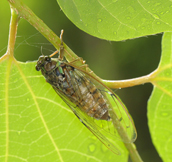
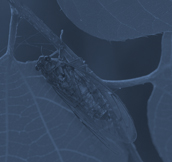 Tanna japonensis Cicadidae
Tanna japonensis Cicadidae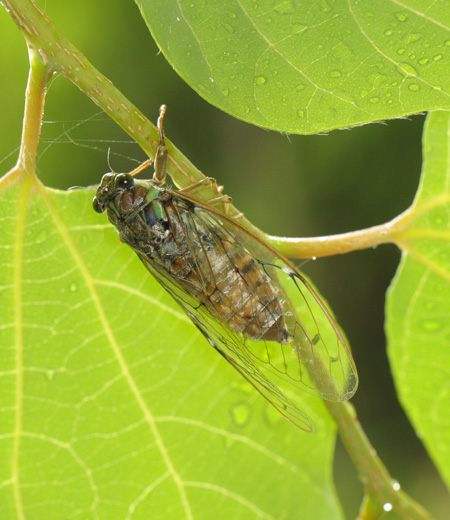 They live in southern part of Hokkaido, main land Honsyu, Shikoku, Kyusyu as well as Yakushima Island.
They live in southern part of Hokkaido, main land Honsyu, Shikoku, Kyusyu as well as Yakushima Island.
They inhabit mainly in copse in plain ground and at the low mountain areas.
They are the kind that show up rather early season like June, and the breeding high season comes at most in July.
They chirp with accordance with their name ‘Hi-Gu-Ra-Shi’ (Evening cicada) at evening twilight time, such as metallic chirping ‘He-He-He-He-He…’.
Their chirp is often expressed as ‘Kana-Kana’ literary. Very early morning at the breaking dawn when it’s still in the darkness or when it comes to cloudy day, they chirp even during daytime.
The body color depends upon each one, but most of them have the dark reddish-brown base color with patterns of green and black here and there.
Most male have large swollen abdomen that is air bag, while female is sharp rear due to ovipositor (tubular organ used for laying eggs).
Sometimes we notice that white cotton like thing adheres to them; this is larva of Epipomponia nawai that parasite original breed.
●Length(overall-length from head to wing) about 40 to 50 mm
●Adult Flight Season June to about September -
Oncotympana maculaticollis Cicadidae
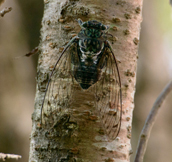
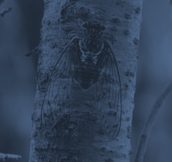 Oncotympana maculaticollis Cicadidae
Oncotympana maculaticollis Cicadidae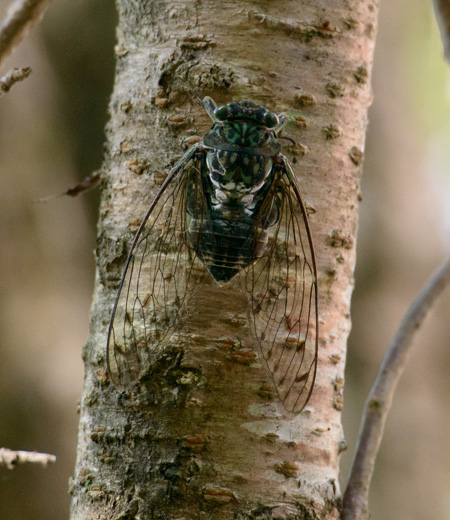 They live in southern part of Hokkaido, main land Honsyu, Shikoku, Kyusyu as well as Tsushima Island.
They live in southern part of Hokkaido, main land Honsyu, Shikoku, Kyusyu as well as Tsushima Island.
They inhabit in copse in plain ground and at mountain areas.
In the Kanto region they are so popular that we can often see them as many times as we do Graptopsaltria nigrofuscata at the city roadside trees or at the trees in the park.
They begin to boom to appear around in middle of July. As their chirp shows it, they sing loud like ‘Min-Min-Min’ (chirp sound of a robust cicada).
Their body has mottles of black color and green color with its center being spouted by white powder.
Rare ones of them include the one with entire body all black, or the one with entire body all green which is called ‘Mikado Type’.
Their wings are transparent and almost twice as long as their body.
Like the other bees, they take a sip of sap by piercing their sharp bait into the trees.
It takes 6 years that incubated larvae become imagines.
●Length(overall-length from head to wing) about 55 to 63 mm
●Adult Flight Season July to about September -
Sastragala esakii Acanthosomatidae
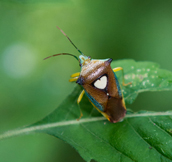
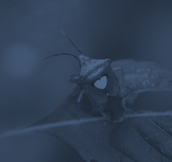 Sastragala esakii Acanthosomatidae
Sastragala esakii Acanthosomatidae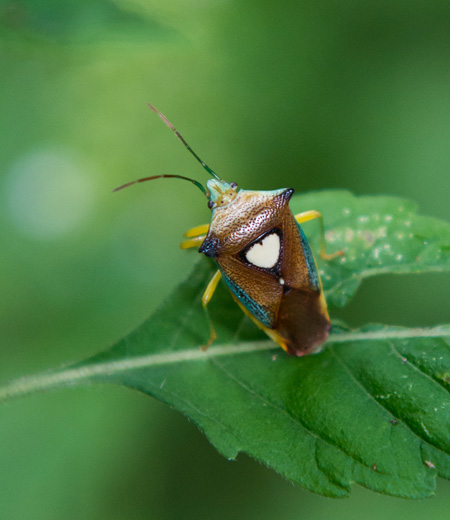 Main Region: Honshu, Shikoku, Kyushu, Tsushima and Amami Island.
Main Region: Honshu, Shikoku, Kyushu, Tsushima and Amami Island.
Found in woods and grasslands from flatlands to mountains.
Color on the back is brown and front part of abdomen from fore wings and legs are green to yellow-green.
Is a family of acanthosomatidae which thorax is angulated.
This species have striking heart-shaped yellow-white pattern.
Named after Japanese entomologist Prof. Teiso Esaki.
Feed on sap of giant dogwood, Toxicodendron succedaneum, oudo and Japanese Prickly-ash and often found on these trees.
Female lay eggs on the back of leaves including giant dogwood and usually guards them by holding and covering them.
Continue to protect hatched nymphs from external enemies.
●Length about 10 to 12 mm
●Adults Flight Season May to about October -
Poecilocoris lewisi Scutelleridae
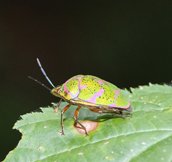
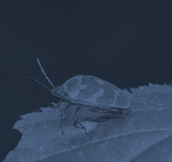 Poecilocoris lewisi Scutelleridae
Poecilocoris lewisi Scutelleridae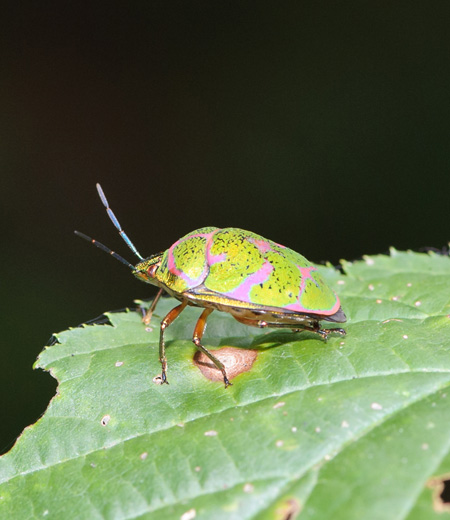 Main Region: Honshu, Shikoku and Kyushu.
Main Region: Honshu, Shikoku and Kyushu.
Found in woods and green space from flatlands to mountains.
Body color is metallic green with copperish red stripe patterns as the Japanese name Aka-suji-kinkamemushi literally meaning red stripe scutelleridae states.
Are well known as one of the beautiful species.
Nymphs are white with black patterns that are completely different from colorful adults body color.
Emerged to adults around June, are often rest on trunks or leaves of trees.
Feed on sap of stachyurus praecox, alder, Japanese cypress, giant dogwood, Cryptomeria japonica and Japanese Prickly-ash by piercing sharp mouthpart to tree barks.
Nymphs feed on sap of trees, fruits and leaves.
●Length about 17 to 20 mm
●Adults Flight Season June to about August -
Bothrogonia ferruginea Cicadellidae
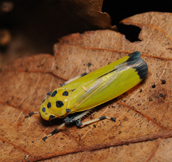
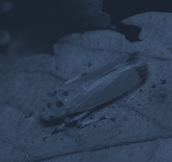 Bothrogonia ferruginea Cicadellidae
Bothrogonia ferruginea Cicadellidae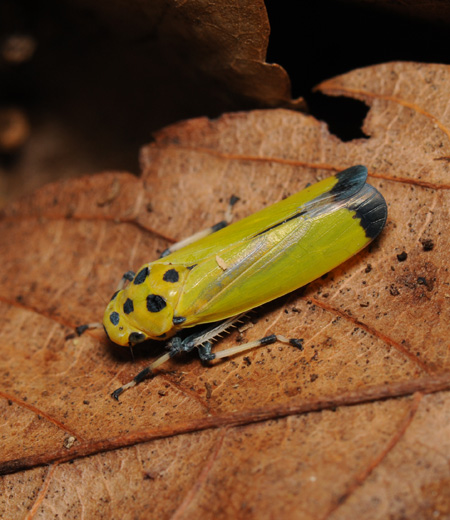 Main Region: Honshu, Shikoku, Kyushu and Okinawa.
Main Region: Honshu, Shikoku, Kyushu and Okinawa.
Found in woods and surrounding green space and croplands and even at gardens in cities from flatlands to low elevations.
Body color is green to yellow-green with black spots on head and thorax and black parts on lower parts of wings, hence the Japanese name Tsumaguro-oo-yokobai corner black large homoptera.
Rest on the back of leaves on grass during daytime and become active at night and also are attracted to lights.
Feed on sap of trees including mulberry, strawberry and in vitaceae family but foot plants varies and often cause damage to crops.
When noticing dangers, move quickly sideways as Japanese name yokobai (homoptera) literally meaning to move sideways states, and hide themselves on the back of leaves.
●Length about 6 to 8 mm
●Adults Flight Season March to about November -
Geisha distinctissima Flatidae
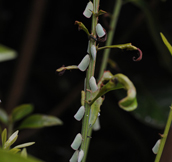
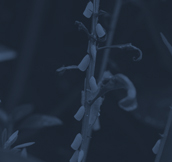 Geisha distinctissima Flatidae
Geisha distinctissima Flatidae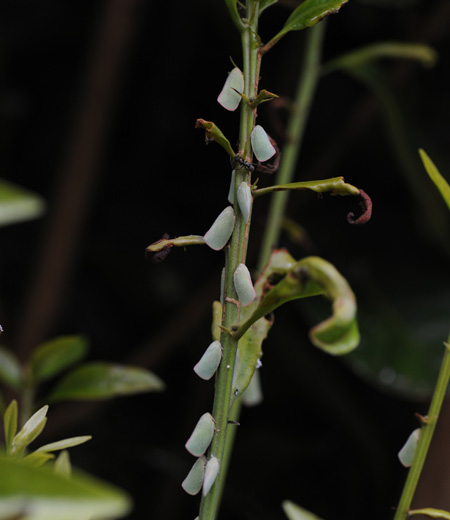 Main Region: Honshu, Shikoku, Kyushu and Nansei Islands.
Main Region: Honshu, Shikoku, Kyushu and Nansei Islands.
Found in woods, green space and flowerbeds from flatlands to mountains.
The entire body is beautiful light green with pink edged triangular-shaped forewings that the Japanese name Aoba-Hagoromo literally meaning blue leave plumage is very suitable for this species.
Hind wings are white and normally covered by fore wings.
Species in ricaniidae family normally rest with wings spread out to their sides but this species rest with wings held close to the body in a vertical position.
Adults are seen from mid-July to late-July and often found on trees in groups.
Fly away immediately at a touch.
Both nymphs and adults feed on sap of trees including mulberry and in rutaceae family.
In early summer around May, emerged nymphs cover their body with white cotton-like filaments to protect themselves from foreign enemies.
●Length about 9 to 11 mm
●Adults Flight Season July to about October -
Orosanga japonicus Ricaniidae
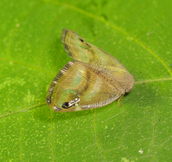
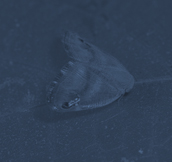 Orosanga japonicus Ricaniidae
Orosanga japonicus Ricaniidae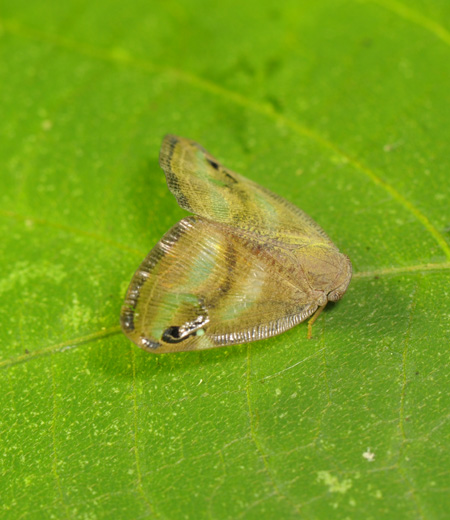 Main Region: Honshu, Shikoku, Kyushu, Okinawa, Yaku Island and Tsushima.
Main Region: Honshu, Shikoku, Kyushu, Okinawa, Yaku Island and Tsushima.
Found in sunny woods and open grasslands from flatlands to low elevations, and even in cities where plants grow.
A part of ricaniidae family.
Body color varies by species but mostly yellow-brown to brown with transparent thick belt-like parts.
Have black spots at tips of wings that resemble moths when resting with wings spread out to the sides.
Pierce needle-like mouthparts to stems of plants including citrus trees such as mandarin orange, in fabaceae family such as kudzu, Japanese yam and Deutzia crenata and suck sap.
Nymphs have brown and white irregular patterns with light yellow cotton-like hair at the tip of abdomen.
●Length about 6 to 8 mm
●Adults Flight Season July to about September -
Parapodisma setouchiensis Acrididae

 Parapodisma setouchiensis Acrididae
Parapodisma setouchiensis Acrididae They live widely in Tohoku region to Kinki region in main land Honsyu.
They live widely in Tohoku region to Kinki region in main land Honsyu.
They inhabit in low ground or at low mountain area, and mountain areas as well as in green tracts of land around forest or clump of bushes, trees in low ground and at the low mountain areas.
Though they look like Locust much, even imagines have only half as long as their trunk, they cannot fly.
They are very good at jumping on their rear legs, but as they are not so active in move, their scope of activity is limitedly small.
They are named after the fact they love to eat giant butterbur (Petasites japonicas), while they eat leaves of various plants such as arrowroot (Pueraria lobata).
Imagines begin to appear in last decade of July.
There is not difference between male and female in body color, but male bees are larger than females ones. Also, male ones have projection portion at abdomen.
The group of Melanoplinae has so many similar kinds that we cannot tell which one it is only by the appearance when we see one outside.
●Length about 22 to 30 mm
●Adult Flight Season July to about September -
Tettigonia orientalis Tettigoniidae
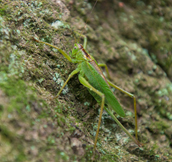
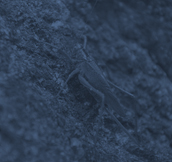 Tettigonia orientalis Tettigoniidae
Tettigonia orientalis Tettigoniidae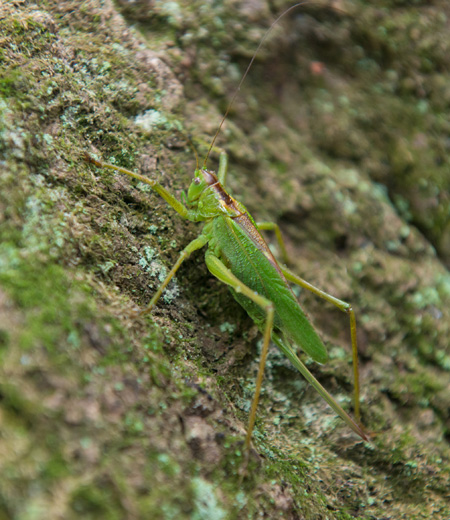 They live widely in main land Honsyu, Shikoku, Kyusyu.
They live widely in main land Honsyu, Shikoku, Kyusyu.
Among Tettigoniidae, they choose to inhabit at bushes in low ground and mountain areas, and at in green tracts of land around forest, which are rather higher places.
The entire boy color is green with its back brown colored and like being one stripe.
Wings are the same green as the body color.
Imagines begin to appear in last decade of June, when their unique chirping can be heard ‘Buzzing’.
As their larvae are herbivorous, their main bait is leaves of grass and pollen of flowers, but as they grow up the imagines gradually become more and more carnivorous so that they occasionally attack insects as large as themselves to get to eat.
Therefore, their legs have such many sharp spines as they catch insects to eat.
●Length about 30 to 40 mm
●Adult Flight Season June to about September -
Oecanthus longicauda Gryllidae
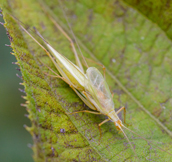
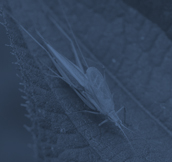 Oecanthus longicauda Gryllidae
Oecanthus longicauda Gryllidae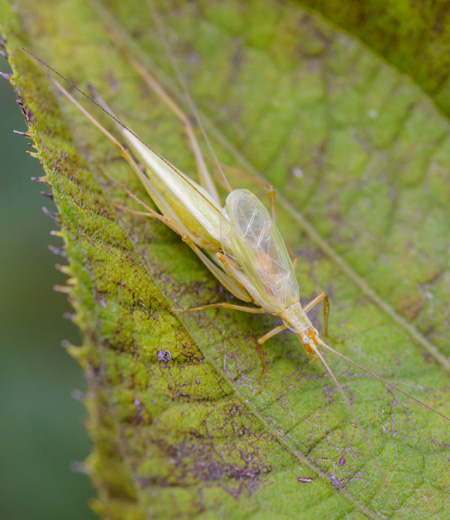 They live in Hokkaido, main land Honsyu, Shikoku, Kyusyu.
They live in Hokkaido, main land Honsyu, Shikoku, Kyusyu.
They inhabit at grassy places and in green tracts of land in plain ground and in low mountain areas.
The entire boy color is pale green and thin.
They look like grasshoppers, but they belong to Gryllidae group.
Their antennae are three times as long as the body itself.
As their main bait is arrowroot (Pueraria lobata) and Japanese mugwort (Artemisia princeps), we can find them so often at the back of leaves at the grassy places where their favorite plants grow.
They also eat small insects such as Aphidoidea.
In fact, they are famous as singing insects in autumn, all the more, their singing voice is so clear and refreshing that it has been praised as ‘Queen of Singing Insects’.
Thus, their name is one of the seasonal words (Ki-Go) for autumn.
●Length about 15 mm
●Adult Flight Season August to about November -
Prosopogryllacris japonica Gryllacrididae
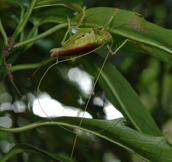
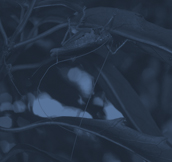 Prosopogryllacris japonica Gryllacrididae
Prosopogryllacris japonica Gryllacrididae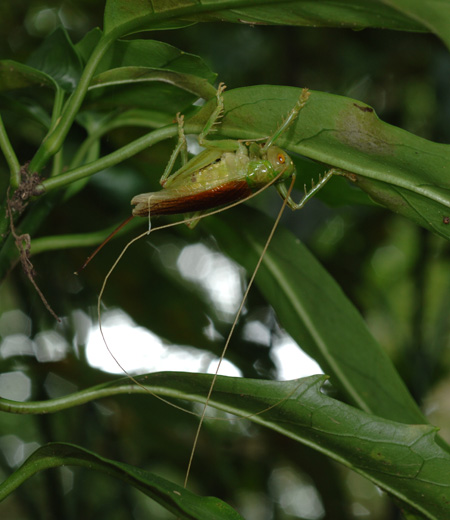 They live widely in main land Honsyu, Shikoku, Kyusyu.
They live widely in main land Honsyu, Shikoku, Kyusyu.
They inhabit at bushes and in green tracts of grassy places in plain ground to mountain areas.
Their name originally comes from the fact that they have interim characteristics between Cricket and long-horned grasshopper.
As being nocturnal, they are seldom known among the public.
Prosopogryllacris japonicas don’t sing because they have no singing organ system that Cricket and long-horned grasshopper have for singing. Whole body is shiny yellow-green color with the back of front wings in dark reddish-brown.
Their antennas are very long enough to be more than three times as long as the body length.
They spit out adhesive spinning silk, which they utilize to make their breeding place by adhering one leaf to another.
This is where they spend day time mostly.
At night they get vigor and have bait like insects on the trees.
They also love sap of trees and nectar of flower.
●Length about 30 to 40 mm
●Adult Flight Season July to about September -
Tenodera angustipennis(Narrow-winged Mantis) Mantidae
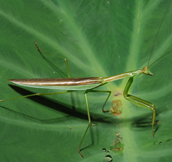
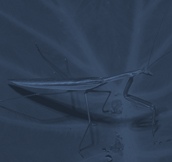 Tenodera angustipennis(Narrow-winged Mantis) Mantidae
Tenodera angustipennis(Narrow-winged Mantis) Mantidae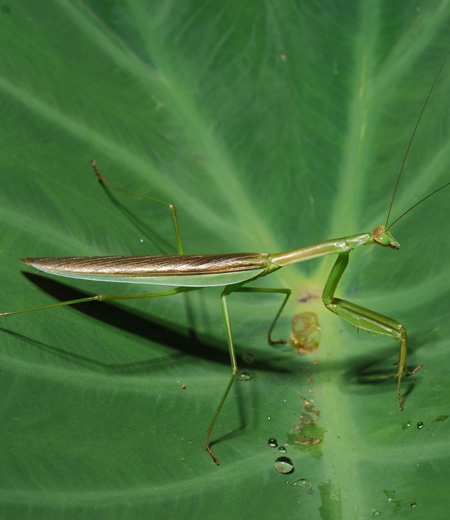 Main Region: Honshu, Shikoku, Kyushu and Nansei Islands. Found in grasslands from flatlands to mountains, riverbeds and parks in cities. Is most frequently found mantis and often called simply as mantis. Body color is either green or brown. grasping front legs are like sickles that are suitable for catching small insects that they are feed on. Rest on grass or trunks of trees and catch insects approached to them immediately with the fast front legs movement. Adults are also found near flowers in cirsium family. Have orange spots on the base of front legs. Similar Tenodera aridifolia have orange spots that are to distinguish this species. In autumn, female lays batches of eggs covered with sponge-like egg cases, called ootheca.
Main Region: Honshu, Shikoku, Kyushu and Nansei Islands. Found in grasslands from flatlands to mountains, riverbeds and parks in cities. Is most frequently found mantis and often called simply as mantis. Body color is either green or brown. grasping front legs are like sickles that are suitable for catching small insects that they are feed on. Rest on grass or trunks of trees and catch insects approached to them immediately with the fast front legs movement. Adults are also found near flowers in cirsium family. Have orange spots on the base of front legs. Similar Tenodera aridifolia have orange spots that are to distinguish this species. In autumn, female lays batches of eggs covered with sponge-like egg cases, called ootheca.
●Length about 65 to 90 mm
●Adults Flight Season August to about October -
Statilia maculata Mantidae
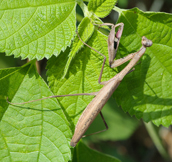
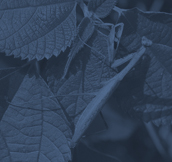 Statilia maculata Mantidae
Statilia maculata Mantidae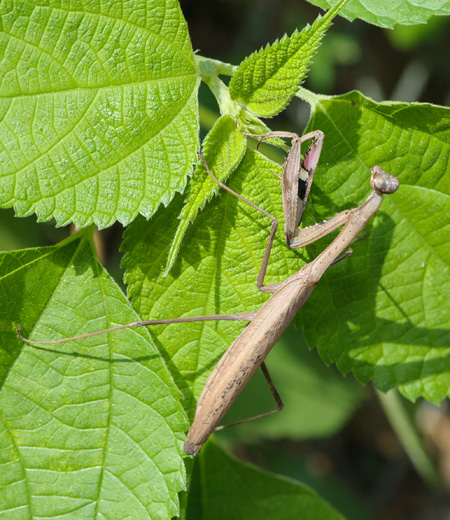 Main Region: Honshu, Shikoku, Kyushu, Izu Islands, Tsushima and Yaku Island. Found in forest and grasslands from flatland to mountains and farmlands. Body color is ocher to dark brown for most of species but green in rare cases. Inner sides of grasping front legs are black which is quite distinctive. When plants are green, found on ground or trees and in autumn found often on dead leaves. Ootheca is elongated and female lays them on rocks or tree trunks close to the ground.
Main Region: Honshu, Shikoku, Kyushu, Izu Islands, Tsushima and Yaku Island. Found in forest and grasslands from flatland to mountains and farmlands. Body color is ocher to dark brown for most of species but green in rare cases. Inner sides of grasping front legs are black which is quite distinctive. When plants are green, found on ground or trees and in autumn found often on dead leaves. Ootheca is elongated and female lays them on rocks or tree trunks close to the ground.
●Length about 36 to 60 mm
●Adults Flight Season August to about November -
Acromantis japonica Acromantidae
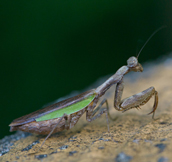
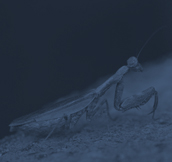 Acromantis japonica Acromantidae
Acromantis japonica Acromantidae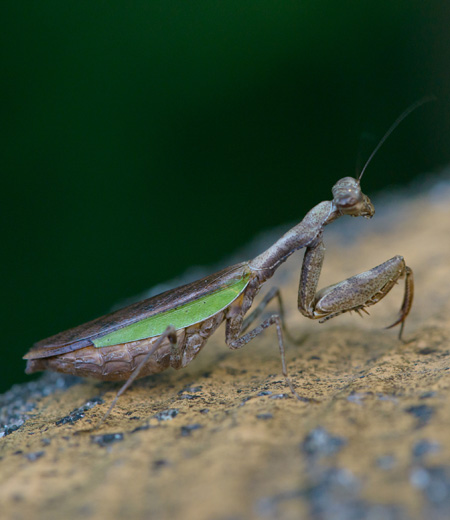 Main Region: Honshu, Shikoku, Kyushu and Nansei Islands. Found in woods and surrounding grasslands from low elevations to mountains. Is a very small mantis. Even the body size is around 3 cm, have big wings covering abdomen that is to identify adults. Body color is green and brown and some have mixed color for example brown on back and green on grasping front legs. When sensing dangers, stop moving and hold the body low, and drop itself to the ground. Sometimes place legs right beside abdomen pretending to be dead. Head is wide triangular-shaped with protruding compound eyes on either side. Nymphs emerged from eggs are black like ants.
Main Region: Honshu, Shikoku, Kyushu and Nansei Islands. Found in woods and surrounding grasslands from low elevations to mountains. Is a very small mantis. Even the body size is around 3 cm, have big wings covering abdomen that is to identify adults. Body color is green and brown and some have mixed color for example brown on back and green on grasping front legs. When sensing dangers, stop moving and hold the body low, and drop itself to the ground. Sometimes place legs right beside abdomen pretending to be dead. Head is wide triangular-shaped with protruding compound eyes on either side. Nymphs emerged from eggs are black like ants.
●Length about 25 to 32 mm
●Adults Flight Season June to about October
